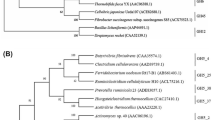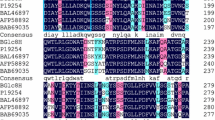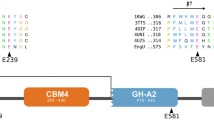Abstract
From a biogas reactor metagenome an ORF (bp_cel9A) encoding a bacterial theme C glycoside hydrolase family 9 (GH9) enzyme was recombinantly produced in E. coli BL21 pQE-80L. BP_Cel9A exhibited ≤ 55% identity to annotated sequences. Subsequently, the enzyme was purified to homogeneity by affinity chromatography. The endo-beta-glucanase BP_Cel9A hydrolyzed the beta-1,3–1,4-linked barley beta-glucan with 24 U/mg at 30 °C and pH 6.0. More than 62% of activity was measured between 10 and 40 °C. Lichenan and xyloglucan were hydrolyzed with 67% and 40% of activity, respectively. The activity towards different substrates varied with different temperatures. However, the enzyme activity on CMC was extremely low (> 1%). In contrast to BP_Cel9A, most GH9 glucanases act preferably on crystalline or soluble cellulose with only side activities towards related substrates. The addition of calcium or magnesium enhanced the activity of BP_Cel9A, especially at higher temperatures. EDTA inhibited the enzyme, whereas EGTA had no effect, suggesting that Mg2+ may adopt the function of Ca2+. BP_Cel9A exhibited a unique substrate spectrum when compared to other GH9 enzymes with great potential for mixed-linked glucan or xyloglucan degrading processes at moderate temperatures.






Similar content being viewed by others
References
Edney MJ, Marchylo BA, MacGregor AW (1991) Structure of total barley beta-glucan. J Inst Brew 97:39–44
Henrissat B (1991) A classification of glycosyl hydrolases based on amino-acid sequence similarities. Biochem J 280:309–316
Lombard V, Golaconda Ramulu H, Drula E, Coutinho PM, Henrissat B (2014) The carbohydrate-active enzymes database (CAZy) in 2013. Nucleic Acids Res 42:D490–D495
Ravachol J, Borne R, Tardif C, de Philip P, Fierobe H-P (2014) Characterization of all family-9 glycoside hydrolases synthesized by the cellulosome-producing bacterium Clostridium cellulolyticum. J Biol Chem 289(11):7335–7348
Gilad R, Rabinovich L, Yaron S, Bayer EA, Lamed R, Gilbert HJ, Shoham Y (2003) CelI, a noncellulosomal family 9 enzyme from Clostridium thermocellum, is a processive endoglucanase that degrades crystalline cellulose. J Bacteriol 185(2):391–398
Jindou S, Xu Q, Kenig R, Shulman M, Shoham Y, Bayer EA, Lamed R (2006) Novel architecture of family-9 glycoside hydrolases identified in cellulosomal enzymes of Acetivibrio cellulolyticus and Clostridium thermocellum. FEMS Micrbiol Lett 254:308–316
Bai Y, Wang J, Zhang Z, Shi P, Luo H, Huang H, Luo C, Yao B (2010) A novel family 9 β-1,3(4)-glucanase from thermoacidophilic Alicyclobacillus sp. A4 with potential applications in the brewing industry. Appl Microbiol Biotechnol 87:251–259
Li S, Sauer WC, Huang SX, Gabert VM (1996) Effect of beta-glucanase supplementation to hulless barley- or wheat-soybean meal diets on the digestibilities of energy, protein, beta-glucans, and amino acids in young pigs. J Anim Sci 74(7):1649–1656
Pessoa Furtado G, Ferreira Ribeiro L, Ramos Santos C, Caldana Tonoli C, Rodriguez de Souza A, Rocha Oliveira R, Tyago Murakami M, Ward RJ (2011) Biochemical and structural characterization of a beta-1,3–1,4-glucanase from Bacillus subtilis 168. Process Biochem 46:1202–1206
Ishikawa J, Hotta K (1999) FramePlot: a new implementation of the frame analysis for predicting protein-coding regions in bacterial DNA with a high G+C content. FEMS Microbiol Lett 174:251–253
Altschul SF, Gish W, Miller W, Myers EW, Lipman DJ (1990) Basic local alignment search tool. J Mol Biol 215:403–410
Marchler-Bauer A et al (2015) CDD: NCBI’s conserved domain database. Nucleic Acids Res 43(D):222–226
Sievers F, Wilm A, Dineen DG, Gibson TJ, Karplus K, Li W, Lopez R, McWilliam H, Remmert M, Söding J, Thompson JD, Higgins D (2011) Fast, scalable generation of high-quality protein multiple sequence alignments using Clustal Omega. Mol Syst Biol 7:539
Arnold K, Bordoli L, Kopp J, Schwede T (2006) The SWISS-MODEL workspace: a web-based environment for protein structure homology modeling. Bioinformatics 22:195–201
Guex N, Peitsch MC (1997) SWISS-MODEL and the Swiss-PdbViewer: an environment for comparative protein modeling. Electrophoresis 18(15):2714–2723
Laemmli UK (1970) Cleavage of structural proteins during the assembly of the head of bacteriophage T4. Nature 227:680–685
Miller GL (1959) Use of dinitrosalicylic acid reagent for determination of reducing sugar. Anal Chem 31:426–428
Britton HTS, Robinson RA (1931) Universal buffer solutions and the dissociation constant of veronal. J Chem Soc 1456–1462
Bradford MM (1976) A rapid and sensitive method for the quantitation of microgram quantities of protein utilizing the principle of protein-dye binding. Anal Biochem 72:248–254
Duan C-J, Huang M-Y, Pang H, Zhao J, Wu C-X, Feng J-X (2017) Characterization of a novel theme C glycoside hydrolase family 9 cellulase and its CBM-chimeric enzymes. Appl Microbiol Biotechnol 101:5723–5737
Juy M, Amit AG, Alzari PM, Poljak RJ, Claeyssens M, Beguin P, Aubert J-P (1992) Three-dimensional structure of a thermostable bacterial cellulase. Nature 357:89–91
Schubot FD, Kateava IA, Chang J, Shah AK, Ljungdahl LG, Rose JP, Wang B-C (2004) Structural basis for the exocellulase activity of the cellobiohydrolase CbhA from Clostridium thermocellum. Biochemistry 43(5):1163–1170
Okano H, Kanaya E, Ozaki M, Angkawidjaja C, Kanaya S (2015) Structure, activity, and stability of metagenome-derived glycoside hydrolase family 9 endoglucanase with an N-terminal Ig-like domain. Protein Sci 24:408–419
Pereira JH, Sapra R, Volponi JV, Kozina CL, Simmons B, Adams PD (2009) Structure of endoglucanase Cel9A from the thermoacidophilic Alicyclobacillus acidocaldarius. Acta Cryst D 65:744–750
Wang H-J, Hsiao Y-Y, Chen Y-P, Ma T-Y, Tseng C-P (2016) Polarity alteration of a calcium site induces a hydrophobic interaction network and enhances Cel9A endoglucanase thermostability. Appl Environ Microbiol 82:1662–1674
Fu X, Liu P, Lin L, Hong Y, Huang X, Meng X, Liu Z (2010) A novel endoglucanase (Cel9P) from a marine Bacterium Paenibacillus sp. BME-14. Appl Biochem Biotechnol 160:1627–1636
Kataeva IA, Uversky VN, Brewer JM, Schubot F, Rose JP, Wang BC, Ljungdahl LG (2004) Interactions between immunoglobulin-like and catalytic modules in Clostridium thermocellum cellulosomal cellobiohydrolase CbhA. Protein Eng Des Sel 17:759–769
Eckert K, Zielinski F, Leggio LL, Schneider E (2002) Gene cloning, sequencing, and characterization of a family 9 endoglucanase (CelA) with an unusual pattern of activity from the thermoacidophile Alicyclobacillus acidocaldarius ATCC27009. Appl Microbiol Biotechnol 60:428–436
Zhang C, Zhang W, Lu X (2015) Expression and characteristics of a Ca2+-dependent endoglucanase from Cytophaga hutchinsonii. Appl Microbiol Biotechnol 99:9617–9623
Qi M, Jun H-S, Forsberg CW (2008) Cel9D, an atypical 1,4-β-D-glucan glucohydrolase from Fibrobacter succinogenes: characteristics, catalytic residues, and synergistic interactions with other cellulases. J Bacteriol 190:6 1976–1984
ul Haq I, Akram F, Khan MA, Hussain Z, Nawaz A, Iqbal K, Shah AJ (2015) CenC, a multidomain thermostable GH9 processive endoglucanase from Clostridium thermocellum: cloning, characterization and saccharification studies. World J Microbiol Biotechnol 31:1699–1710
Chauvaux S, Beguin P, Aubert J-P, Bhat KM, Gow LA, Wood TM, Bairoch A (1990) Calcium-binding affinity and calcium-enhanced activity of Clostridium thermocellum endoglucanase D. Biochem J 265:261–265
Acknowledgements
Thanks are due to the BENAS Biogasanlage GmbH for the possibility of sampling the biogas plant.
Author information
Authors and Affiliations
Corresponding author
Ethics declarations
Conflict of interest
The authors declare that they have no conflict of interest.
Rights and permissions
About this article
Cite this article
Schröder, C., Burkhardt, C., Busch, P. et al. Characterization of a Theme C Glycoside Hydrolase Family 9 Endo-Beta-Glucanase from a Biogas Reactor Metagenome. Protein J 37, 454–460 (2018). https://doi.org/10.1007/s10930-018-9787-5
Published:
Issue Date:
DOI: https://doi.org/10.1007/s10930-018-9787-5




